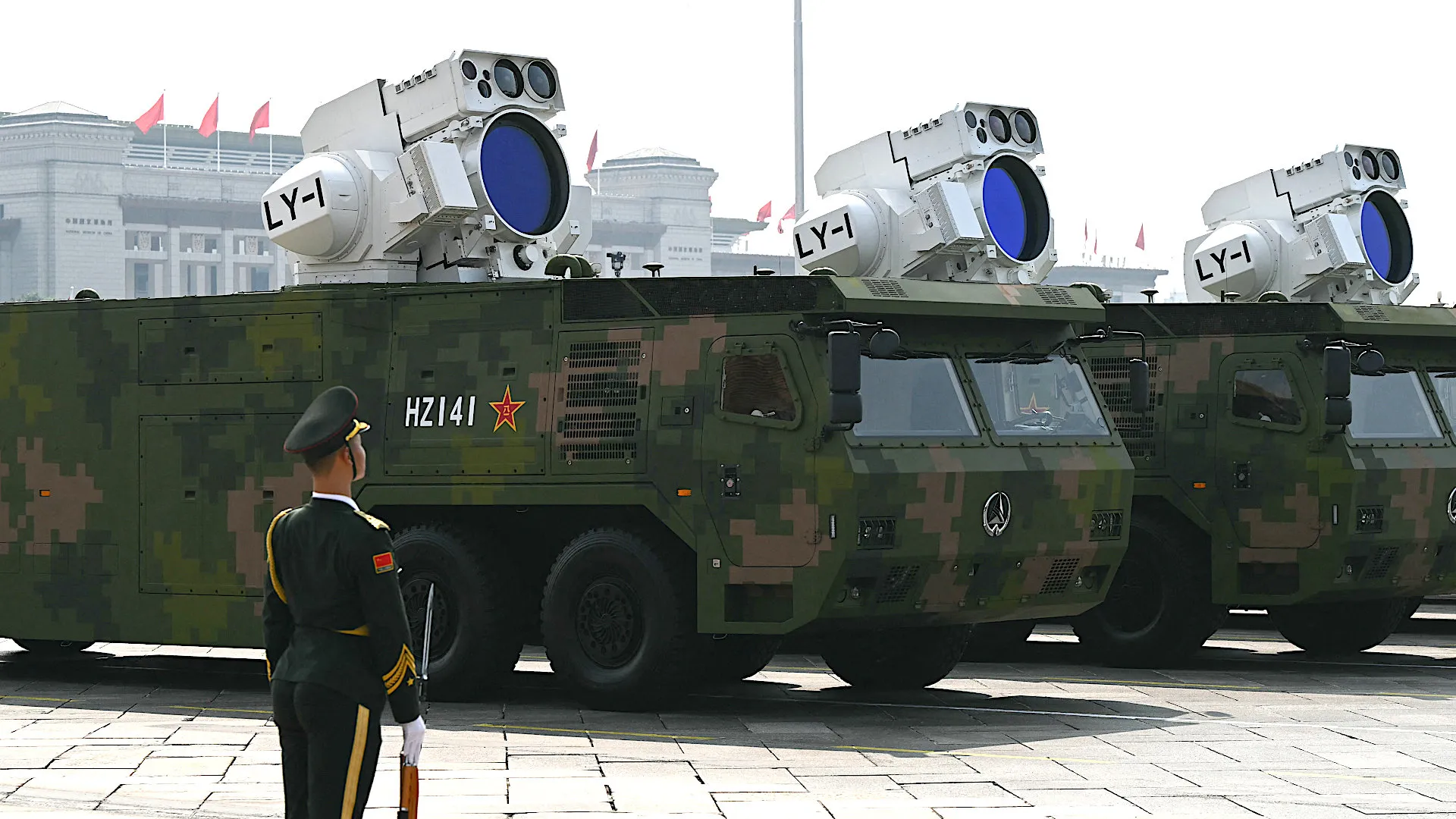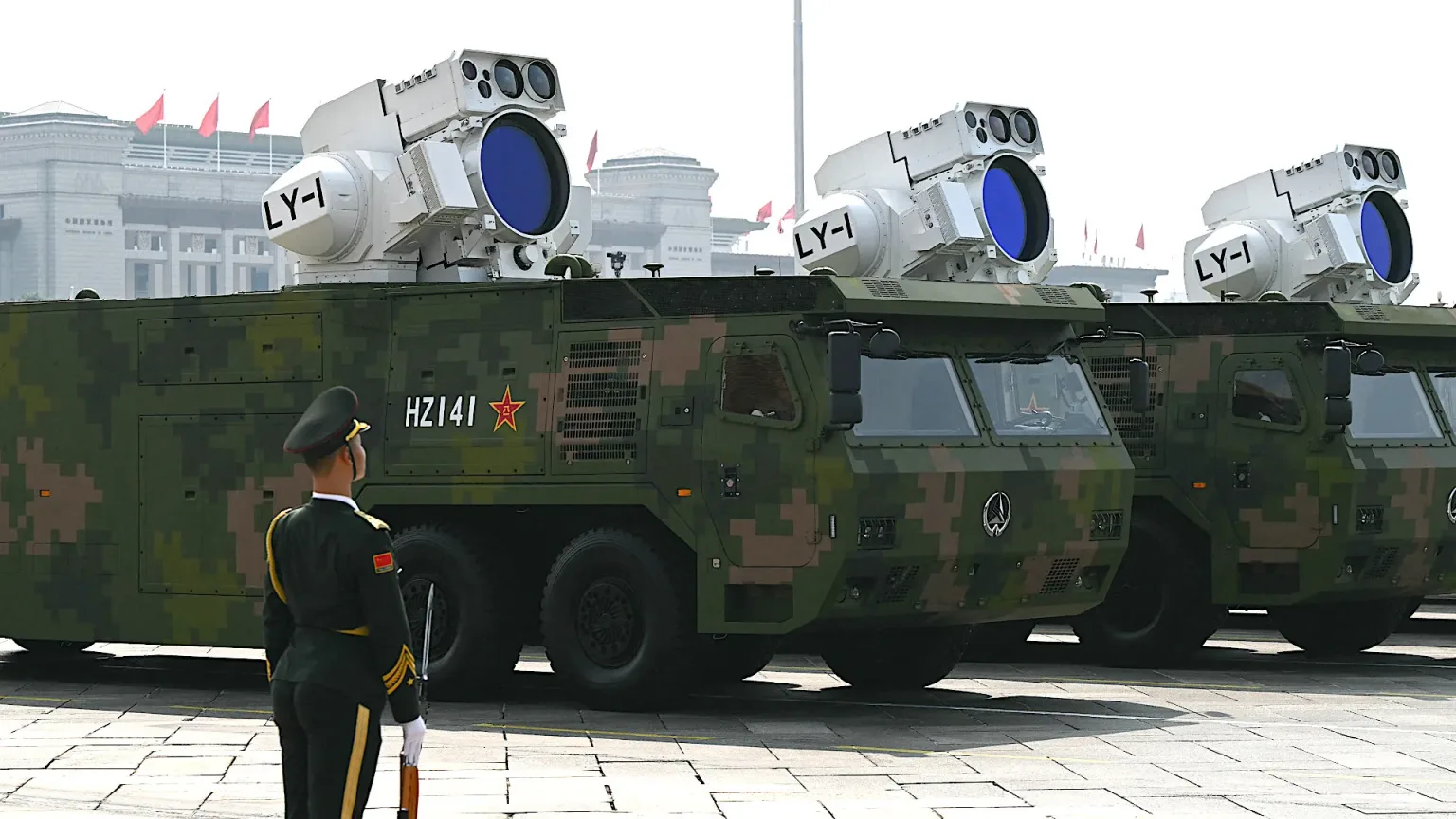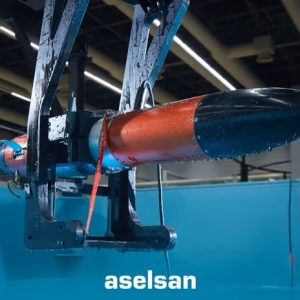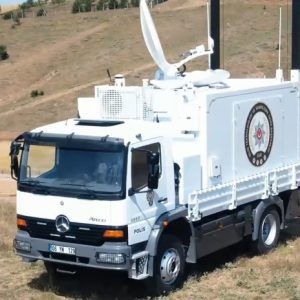China’s new LY-1 laser air defense system drew global attention after its public debut during Beijing’s 80th‑anniversary Victory Day parade on 3 September 2025. Presented as a shipborne layer that can also operate from land vehicles, LY‑1 signals an accelerated move to hard‑kill low, slow, small threats and to degrade optical seekers on faster missiles at close range. This article evaluates the system’s likely architecture, operational value, and constraints, situating it within the emerging economics of counter-UAS and close-in defense. [1] [2]
Overview: What is LY‑1?
At its core, the LY‑1 laser air defense is a turreted high‑energy laser (HEL) with integrated electro‑optical/infrared (EO/IR) tracking. It is designed to deliver two families of effects: rapid burn‑through on polymer‑rich airframes typical of small UAS, and functional kill by damaging seeker windows, gimbals, or focal‑plane arrays on guided munitions. The platform appears modular across naval and road‑mobile configurations, implying doctrine that spans pier and port security, convoy escort, and embarked ship defense. [1]

Key Facts — LY‑1 at a glance
• Debut: 3 September 2025, Beijing parade; messaging prioritizes ship defense, with a purpose‑built 8×8 displayed for land roles. [1]
• Role: Directed‑energy layer against drones and select missiles; enables both sensor‑dazzle and hard‑kill, depending on dwell and aimpoint. [1] [7]
• Architecture: Large‑aperture beam director in a stabilized turret; multiple EO/IR apertures for passive tracking; likely integrated with shipboard power and C2. [1]
• Status: Specifications undisclosed; physical scale suggests high‑energy class with substantial power and cooling; naval and land employment envisioned. [1] [2]
• Context: One element of a Chinese C‑UAS “triad,” paired with kinetic SHORAD and high‑power microwaves (HPM). [3] [4]
## Technical architecture and plausible performance
### Beam director, tracking, and jitter control
The turret’s circular primary aperture, flanked by smaller sensor ports, indicates a combined beam director and multi‑band EO/IR suite. Accordingly, effective HEL employment depends on keeping a high Strehl ratio on target; thus, the system likely blends inertial stabilization, gimbal control, and image‑based tracking to minimize line‑of‑sight jitter. Effective HEL employment depends on keeping a high Strehl ratio on target; thus, the system likely blends inertial stabilization, gimbal control, and image‑based tracking to minimize line‑of‑sight jitter. The geometry visible in parade imagery supports an integrated, closed‑loop director rather than a bolt‑on sensor mast. [1]
### Power supply, thermal management, and duty cycle
HEL usefulness scales with sustained power on target and duty cycle. Therefore, even modest improvements in cooling can translate into longer dwell or faster re‑engagements. Although China has not disclosed ratings, the turret volume and vehicle footprint imply generous space, weight, and power (SWaP) for generation and cooling. On ships, available electrical capacity and chilled‑water loops can extend firing sequences and accelerate cooldowns. By contrast, on trucks, packaged gensets and liquid cooling will cap dwell times and re‑engagement tempo. As a result, naval integration should deliver the most robust sustained effects. [1]
### Engagement mechanics and aimpoint strategy
Against multicopters and small fixed‑wing drones, the most efficient aimpoints are arms, rotors, and electronics bays. Moreover, these components fail quickly when heated, which shortens dwell. Against missiles, the windowed seeker and gimbal assembly offer the quickest functional kill. In practice, operators prioritize these aimpoints to minimize energy expenditure. In both cases, plume, aerosols, and platform motion complicate beam quality. Therefore, crews favor short‑lead, multi‑burst dwell rather than single long burns. These tactics align with U.S. and Israeli HEL doctrine and are consistent with LY‑1’s apparent aperture size. [5] [6]
Naval‑first logic, land‑mobile utility
Why sdo hips come first
Parade narration emphasized ship defense, and with good reason. First, ships offer stable platforms, abundant power, and existing combat‑system pipelines for cueing and damage assessment. Consequently, naval integration maximizes duty cycle, tightens sensor fusion, and simplifies thermal management compared with truck platforms. [1]
Land employment and its trade‑offs
Nevertheless, land employment remains attractive for ports, depots, and convoys. However, dust, humidity, and thermal load reduce the average delivered irradiance at the range. Additionally, vibration and alignment drift increase maintenance touch points. Even so, the displayed 8×8 carriage suggests China intends to accept those trade‑offs to extend coverage ashore where weather permits. [5]
Comparative context: Israel and the United States
Iron Beam 450 and the aperture‑first trend
Rafael’s Iron Beam 450, unveiled in September 2025, illustrates a broader shift. Specifically, aperture quality and beam control often dominate raw kilowatts in determining effective range. Consequently, larger, better‑corrected optics preserve spot quality through aerosols and turbulence, which reduces dwell time for a given effect. If LY‑1 follows this path, its aperture choice may be the key driver of performance. Conversely, a smaller aperture would force longer dwell and tighter cueing tolerances. [5]
DE M‑SHORAD lessons on mobility and maintainability
U.S. soldier feedback on Stryker‑mounted lasers is cautionary. Notably, field users flagged heat rejection, calibration drift, and maintenance burdens in dusty, hot environments. Field users flagged heat rejection, calibration drift, and maintenance burdens in dusty, hot environments. Those observations likely translate to LY‑1’s truck variant; consequently, sustainment planning becomes as important as raw power. Meanwhile, naval hulls mitigate some pain through superior power and cooling budgets. However, salt fog, corrosion, and vibration introduce their own tax. [6]
Complementarity with kinetic C‑UAS
HEL does not replace guns and missiles; rather, it reshapes the engagement stack. Consequently, kinetic SHORAD remains essential in rain, fog, and saturation raids. Additionally, the LY‑1 laser air defense adds a low cost‑per‑shot option for exposed foam‑and‑plastic drones and enables rapid retargeting across a swarm. For context on China’s kinetic tier, see our detailed FK‑3000 analysis.
Operational economics and tactics
Cost‑exchange and magazine depth
Directed energy improves the cost‑exchange ratio by trading dollar‑level shots for tens‑of‑thousands‑dollar kinetic rounds. Accordingly, HEL can absorb routine UAS harassment without depleting missile stocks. If LY‑1 sustains tactically useful irradiance, commanders gain a deep magazine. It is limited more by generator capacity and thermal margins than by reload cycles. This is decisive for convoy escorts, port security, and littoral choke points confronted with persistent UAS and glide‑bomb threats. Moreover, it eases logistics during prolonged operations. [5]
Weather, aerosols, and countermeasures
Weather remains the great limiter. Specifically, water vapor, sea spray, and dust scatter energy and broaden the spot, which lengthens dwell times. Water vapor, sea spray, and dust scatter energy and broaden the spot, which lengthens dwell times. Moreover, adversaries can further complicate effects with reflective coatings, spinning airframes, and sacrificial shrouds. Accordingly, a pragmatic CONOPS pairs LY‑1 with radar cueing, EO/IR discrimination, HPM for swarm suppression, and kinetic SHORAD for bad weather and aimpoint‑insensitive hard kills. In turn, this layered approach raises overall system resilience. [3] [4] [5]
Industrial and export considerations
Export prospects hinge less on the laser head than on integration. Consequently, total ownership cost will track the maturity of power, cooling, alignment, and training pipelines. Buyers need power modules, thermal loops, beam director alignment, combat‑system interfaces, and a training and sustainment pipeline. Therefore, early pilot installations should budget for integration risk. China already sells lower‑power laser C‑UAS and offers a vertically integrated catalog of sensors and C2. Thus, it can bundle subsystems to reduce vendor friction. Even where near‑term purchases remain kinetic, LY‑1’s message is clear: allocate space, weight, and power (SWaP) for future directed‑energy growth. Otherwise, retrofit costs will surge. [1]
Bottom line
The LY‑1 laser air defense is neither a silver bullet nor a parade prop. Physics is stubborn, yet the decision to showcase LY‑1 alongside hypersonics and HPM indicates Beijing’s confidence that HEL has crossed from demos into routine close‑in defense. For Allied planners and industry, the implications are concrete: invest in shipboard power and cooling sized for lasers, tighten radar–EO/IR fusion ashore, and treat directed energy as a standard bill‑of‑materials line in the counter‑UAS era. [1] [5] [6]
Further Reading
• Rafael’s Iron Beam 450 and the aperture‑first design trend in high‑energy lasers. [5]
• Soldier feedback on U.S. Stryker lasers and what it implies for land‑mobile HEL. [6]
• Parade coverage confirming LY‑1’s naval emphasis and China’s anti‑drone “triad.” [1] [2] [3]
References
- The War Zone — “China’s Imposing LY‑1 High‑Power Laser Weapon Unveiled At Huge Military Parade,” 3 Sep 2025. Link
- Business Insider — “China’s military showed off laser weapons…,” 3 Sep 2025. Link
- Reuters (graphics) — “China’s war technology on parade,” 3 Sep 2025. Link
- Financial Times — “Lasers, hypersonic missiles and the ‘nuclear triad’…,” 3 Sep 2025. Link
- Breaking Defense — “Rafael unveils Iron Beam 450 laser air defense for DSEI,” 9 Sep 2025. Link
- Breaking Defense — “Army soldiers not impressed with Strykers outfitted with 50‑kilowatt lasers,” 16 May 2024. Link
- France 24 — “Beijing shows off drones, missiles and lasers in military parade,” 3 Sep 2025. Link











